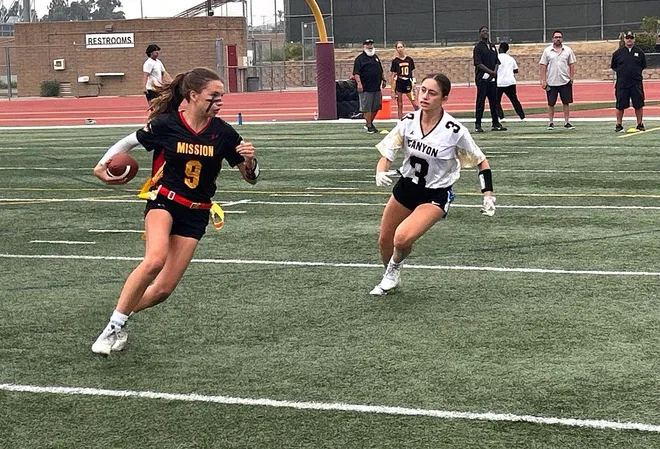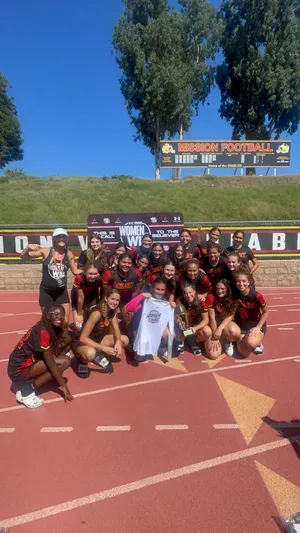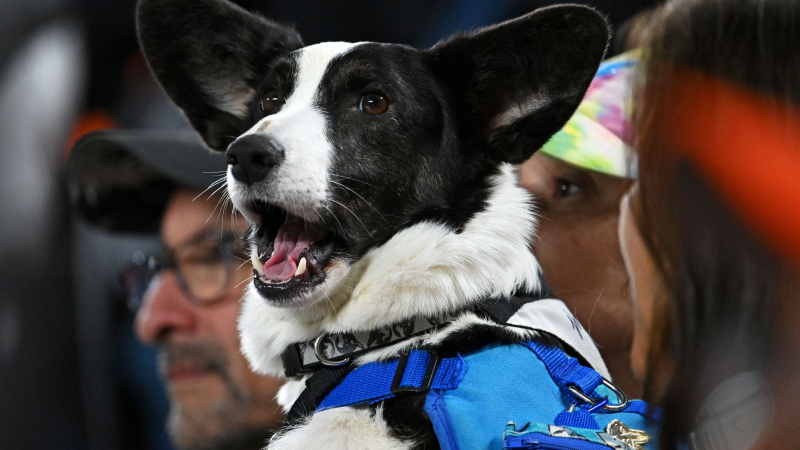'These girls can be pioneers': Why flag football is becoming so popular with kids
“Football belongs to everybody.”
Think about those words and what they mean to you. They probably tell you how much the American version of the sport captivates the country every weekend of the fall.
But consider the source of these words: They’re from a woman, a former Division I athlete but one who never really got a chance to play football.
When Karissa Niehoff sees what’s going on now with the game and its opportunities for girls, her mind goes back to when she was a senior in high school.
“We played Powderpuff against our archrival team, the archrival town and it was essentially a flag situation,” said Niehoff, now the CEO of the National Federation of State High School Associations (NFHS). “But that’s all we had.”
It wasn’t much, a game played by girls as a kind of afterthought to the “real thing” the boys played. Several decades later, though, amid a broader national picture of equity, it’s a sport girls are making distinctly their own.
Flag football has become one of the hottest and fastest growing sports for kids to play For girls specifically, though, it’s one they have seized with a national wave of enthusiasm.
Already soaring in popularity at the youth levels, girls flag football has achieved high school varsity status in eight states (Alabama, Alaska, Arizona, California, Florida Georgia, New York and Nevada) as either a fall or spring sport and 18 more states have pilot programs that could achieve that status soon. There are 15,000-plus girls playing flag football at more than 700 high schools, according to the NFHS.
It's a sport we learned last week will be offered for men and women at the 2028 Los Angeles Olympic Games and one the NFL is supporting with youth initiatives and grant programs to assist states in starting programs at schools.
“The collaboration behind the growth of flag is something we have never seen or been a part of to this degree,” Niehoff told USA TODAY Sports in a phone interview last week. “In terms of the pace of growth, I’d be hard-pressed to say that anything has grown as quickly as flag.
“I’ve just always loved football,” she says, “and I think they’re a lot of women and girls that love football. And so I think an opportunity for them to enter into the sport with a more equitable kind of physical prowess, playing field is really exciting.”
It's also just fun. What is the allure behind this vibrant girls sport that is sweeping America? USA TODAY Sports takes a closer look:

Football is your brother’s game (or your dad’s game); this our game
“We’re representing our school!”
“We’re representing our family!”
“Most of all, we’re representing each other!”
That cheer was captured by a CBS report about a local high school flag football team in the San Francisco Bay Area.
Girls across the country are playing a sport they previously only watched their brothers play. On this team, though, there are two girls who watched their dad play. You may have heard of him – Hall of Fame quarterback Steve Young. He’s now an assistant coach for their team at Menlo School.
Young’s two sons never played football, but daughters Summer and Laila dove in head first at the chance.
“I wanted to do what my dad did and feel what he felt when he was doing this sport,” says Laila, a wide receiver.
Likewise, coaches like Young nationwide are seeing girls experience those “Ah-ha!” moments we all cherish when they throw a spiral, line up for a formation or correctly follow a snap count for the first time.
“They go on four, no one flinched,” Young said in a local TV interview. “And I was like, ‘IT took me 15 years to go on 2. We’d remind ourselves the whole way to the line of scrimmage, ‘It’s two, it’s two,’ and we’d still go offsides. And they get it in 15 seconds.”
Girls are feeling it, and loving it, taking a game with which most of us are familiar and carving it into something distinctly their own.
“I just had a phone call with a gentleman that coaches in North Carolina,” Niehoff told USA TODAY Sports. “Having been a coach of multiple girls sports and teams over the years, he said, ‘When I’ve coached boys, they support one another, of course, but the girls cheer for one another even in practice.’ When somebody does a really good execution of a play or learns a skill, he said, ‘I really like how the girls engage in the camaraderie and the support really overtly.’
"Of course, we have women’s tackle football. We don’t know a lot about it but we have our national team, we’re playing internationally, we’ve got our pathways to tackle, but what flag is doing is engaging kids in football, engaging girls at a younger age."
COACH STEVE: Sports parents, you're out of control; behave or get off the sideline

You make contact without hitting
Flag is football with no hitting, even in a football-crazed state in Alabama. (“NON-CONTACT SPORT,” it says in the state’s rules listed online.) It’s a sport kids can play (and parents can watch) without worrying about being leveled.
But that doesn’t mean they’re not playing football. Down the California coast from Young in San Diego, Drew Brees is an assistant coach with the Santa Fe Christian high school’s girls flag team. Brees, another famed NFL quarterback who retired after the 2020 season, is at the forefront of the flag movement, co-founding the Football ’N’ America youth leagues in 2017 in New Orleans while he still played for the Saints.
He didn’t put on pads until he played tackle football in high school. He learned football’s fundamentals playing flag, a game of strategy and precision.
As they juke and cut through defenders who swipe for their flags, girls are discovering crucial components of football that aren’t always emphasized in a game built on a reputation of being rough.
“The games that we don’t win, we aren’t playing together as a team,” Avery Brewster, a senior co-captain on Mission Viejo’s high school team in California, told USA TODAY Sports. “Sometimes I’ve noticed in tackle football, it’s just like a receiver throwing to one person (and) sometimes it can work because that person’s stronger but with us, with flag football, because we’re not tackling and we’re pulling flags, we have to play together as team.
“If we all don’t run our routes correctly, because there’s no one blocking us, then that leaves our quarterback stranded because nobody’s open. But when we work together as a team, there’s always somebody that’s open when we run our routes correctly and we play better. And the chemistry is there.”
COACH STEVE: Think you're a good sports parent? Coach for Tom Brady, Drew Brees has radical advice for you
It's a sport for everyone
Flag football delves deeply into a component of football we see every time we watch a video of a coach handing out a game ball. The players are gathered around as they are called out for their contributions to the game and the coach’s shoutouts are followed by hoots and hollers.
A 2018 study on teen sport in America by the Women’s Sports Foundation found that boys who participated in full-contact football had some of the highest self-esteems among youth sports participants. It’s a game where youth and high school rosters can go more than 50 deep and yet have each player make a unique contribution and feel a part of the team.
Michele LaBotz, medical director of the athletic training program at the University of New England and a TrueSport Expert Advisory Panel member, cited the study at a media briefing last week hosted by the National Athletic Trainers’ Association. Labotz, though, sees something else at play, too.
“It’ll be interesting to see how this carries over to flag football but (football is) one of the few sports that is really welcoming to the child and adolescent who’s carrying extra weight, especially those that are carrying quite a bit of extra weight who really struggle with finding other opportunities for sport participation,” she says, “and football sometimes is the only option that they have.”
Half of the girls playing flag football in high schools across American, according to the NFSA, weren't even participating in other high school sports before this one came along.
Yes, flag football players already have role models they can emulate like Mexico quarterback Diana Flores, who was featured in a commercial at the last Super Bowl in which she evades a dizzying number of defenders, including broadcaster Erin Andrews and her mother.
But they can also admire the girl next to them who, like them, is trying something new.
“I just think it’s really cool that they have the opportunity to do this and feel included and feel not alone in everything,” says Katie Neilson, another senior co-captain on Mission Viejo’s team in California who has only been playing the sport since her sophomore year. “We’ve all gotten really close with our teammates and it’s really cool to see girls come out of their comfort zone and feel comfortable around us.”
There’s a bright future: ‘These girls can be pioneers’
In California, where girls flag is being offered as a varsity sport for the first time this fall, more than 400 schools are participating in it.
Emmy Walton got a sense of the sport’s soaring popularity when she and her organization, Women of Will (WoW), helped host a tournament at Mission Viejo High last month. The event drew 21 schools from four sports hotbeds in the southern part of the state: Los Angeles County, Orange County, the Inland Empire and San Diego.
“I would have been all over flag football if it was an option for me,” says Walton, a four-year varsity soccer player at Cal State Fullerton and the national account manager for Women of Will.
Women of Will, which partners with apparel and equipment outfits BSN Sports and Under Armour, is a unique, girls-only sports high school sponsorship program. It promotes women’s identities as female athletes as part of a nationwide network that has reached 300-plus schools in almost every stae.
WoW celebrates women's sports through uniform designs but also hypes the players who wear them, hosting days at high schools where girls teams are championed like boys football on homecoming.
“When we grew up, there wasn’t even girls athletic wear,” Walton says. “There wasn’t girls soccer shirts. It was all just like boys, and it was all baggy and everything. Luckily, we’ve got a big highlight and spotlight on females in sport now and we’ve got amazing gear that actually fits our bodies. …
“Part of the Women of Will program is trying to help build female programs, female teams, getting more girls to try out, especially after COVID, (when) we saw a huge decline in sport participation. ... I can’t imagine not having the experiences and the life lessons I learned from playing sports.
“We want to give them something that will leave a legacy of empowering female athletes in creating a culture change on campus of these ladies having a safe space to rise up as leaders.”
It's 'dinner table' fare
It’s been about 20 years since Walton played prep sports. When she walks around a high school campus these days, she gets a much different picture than the one once saw through teenaged eyes.
Students pass her with their heads down or their ears plugged with wireless earpieces. Some of them don’t talk even to the people they pass and see.
Then Walton goes out to the athletic fields or into the gymnasiums. There, the communication is as vibrant as ever. She sees girls like she once was with sense of direction, spirit and purpose. She sees something else, too.
They’re playing football.
“These girls can be pioneers,” she says. “I hope that colleges are seeing how fast this sport is growing and how important it is to offer it.”
With each passing year, Niehoff, the NFHS’ CEO, guesses two to four states will sanction girls flag as a varsity sport. NAIA schools and junior colleges are already offering scholarships for it. Niehoff fully expects the sport to become a Division 1 opportunity to women down the road.
“I think what flag will do for the football in general is have better conversations at the dinner table when Mom or Dad has their child say, ‘I want to play football,’ ” she says. “By getting kids excited about flag, they get excited about football … We’re getting families to embrace the sport of football with a different lens.”
After all, as she knows, football belongs to everybody.
Steve Borelli, aka Coach Steve, has been an editor and writer with USA TODAY since 1999. He spent 10 years coaching his two sons’ baseball and basketball teams. He and his wife, Colleen, are now sports parents for a high schooler and middle schooler. His column is posted weekly. For his past columns, click here.
Got a question for Coach Steve you want answered in a column? Email him at sborelli@usatoday.com

Disclaimer: The copyright of this article belongs to the original author. Reposting this article is solely for the purpose of information dissemination and does not constitute any investment advice. If there is any infringement, please contact us immediately. We will make corrections or deletions as necessary. Thank you.







